英语理论语言学
英语语言学第一章、第二章
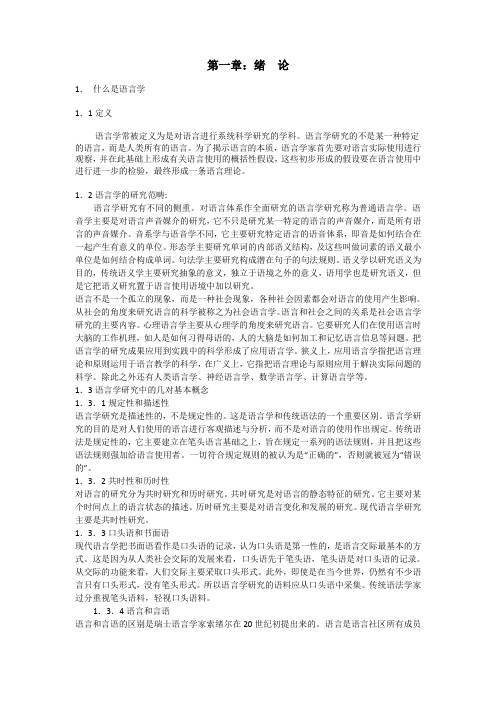
第一章:绪论1.什么是语言学1.1定义语言学常被定义为是对语言进行系统科学研究的学科。
语言学研究的不是某一种特定的语言,而是人类所有的语言。
为了揭示语言的本质,语言学家首先要对语言实际使用进行观察,并在此基础上形成有关语言使用的概括性假设,这些初步形成的假设要在语言使用中进行进一步的检验,最终形成一条语言理论。
1.2语言学的研究范畴:语言学研究有不同的侧重。
对语言体系作全面研究的语言学研究称为普通语言学。
语音学主要是对语言声音媒介的研究,它不只是研究某一特定的语言的声音媒介,而是所有语言的声音媒介。
音系学与语音学不同,它主要研究特定语言的语音体系,即音是如何结合在一起产生有意义的单位。
形态学主要研究单词的内部语义结构,及这些叫做词素的语义最小单位是如何结合构成单词。
句法学主要研究构成潜在句子的句法规则。
语义学以研究语义为目的,传统语义学主要研究抽象的意义,独立于语境之外的意义,语用学也是研究语义,但是它把语义研究置于语言使用语境中加以研究。
语言不是一个孤立的现象,而是一种社会现象,各种社会因素都会对语言的使用产生影响。
从社会的角度来研究语言的科学被称之为社会语言学。
语言和社会之间的关系是社会语言学研究的主要内容。
心理语言学主要从心理学的角度来研究语言。
它要研究人们在使用语言时大脑的工作机理,如人是如何习得母语的,人的大脑是如何加工和记忆语言信息等问题。
把语言学的研究成果应用到实践中的科学形成了应用语言学。
狭义上,应用语言学指把语言理论和原则运用于语言教学的科学,在广义上,它指把语言理论与原则应用于解决实际问题的科学。
除此之外还有人类语言学、神经语言学、数学语言学、计算语言学等。
1.3语言学研究中的几对基本概念1.3.1规定性和描述性语言学研究是描述性的,不是规定性的。
这是语言学和传统语法的一个重要区别。
语言学研究的目的是对人们使用的语言进行客观描述与分析,而不是对语言的使用作出规定。
传统语法是规定性的,它主要建立在笔头语言基础之上,旨在规定一系列的语法规则,并且把这些语法规则强加给语言使用者。
教资英语理论精讲-语言学
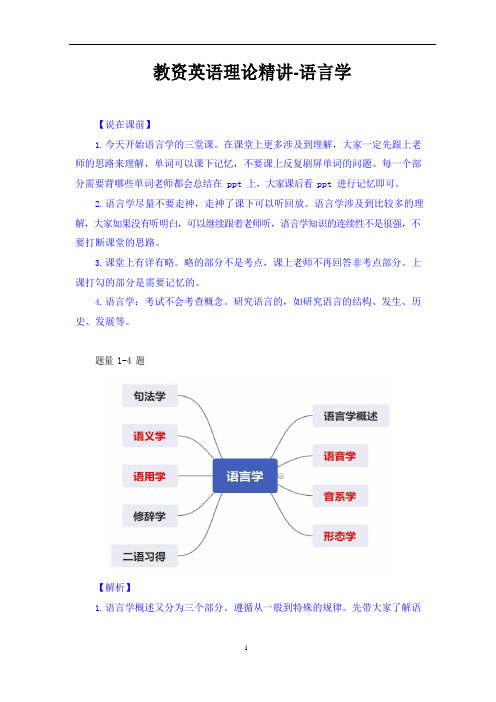
教资英语理论精讲-语言学【说在课前】1.今天开始语言学的三堂课。
在课堂上更多涉及到理解,大家一定先跟上老师的思路来理解,单词可以课下记忆,不要课上反复刷屏单词的问题。
每一个部分需要背哪些单词老师都会总结在 ppt 上,大家课后看 ppt 进行记忆即可。
2.语言学尽量不要走神,走神了课下可以听回放。
语言学涉及到比较多的理解,大家如果没有听明白,可以继续跟着老师听,语言学知识的连续性不是很强,不要打断课堂的思路。
3.课堂上有详有略。
略的部分不是考点,课上老师不再回答非考点部分。
上课打勾的部分是需要记忆的。
4.语言学:考试不会考查概念。
研究语言的,如研究语言的结构、发生、历史、发展等。
题量 1-4 题【解析】1.语言学概述又分为三个部分。
遵循从一般到特殊的规律。
先带大家了解语言学概述,再带大家一个个了解。
2.语言学通常考查 1-4 题,即 2-8 分,能拿到的分数尽量拿。
语言学和语法不一样,只要听懂并记下需要记的单词,8 分一定可以拿到。
3.句法学不考,这里不再赘述。
修辞学和二语习得考查较少,我们会从当中挑选重点概念进行讲解。
标红部分是重点内容。
Part1 语言学概述1.语言学的分类2.语言的本质特征3.语言的主要功能【解析】语言学的分类带着大家看下即可,考试不考。
标红的两个考试考过。
01语言学的分类【解析】语言学分类:微观和宏观语言学,考试的重点是标红。
1.微观语言学:从语音到语用。
从语言的音、形、意、用四个角度进行研究的。
(1)语音学:研究元音和辅音。
(2)音系学:研究发音的内部结构和发音规律。
(3)形态学:研究单词的形,这部分是围绕单词来展开的。
(4)语义学:研究语言的意义。
(5)语用学:研究语言的使用。
2.宏观语言学:将语言学和其他学科拼在一起进行研究。
考试不会考查得这么复杂。
02语言的本质特征(Design features)语言的本质特性,指的是人类固有的,有别于任何其他动物交流系统的特质。
英语语言学 总结
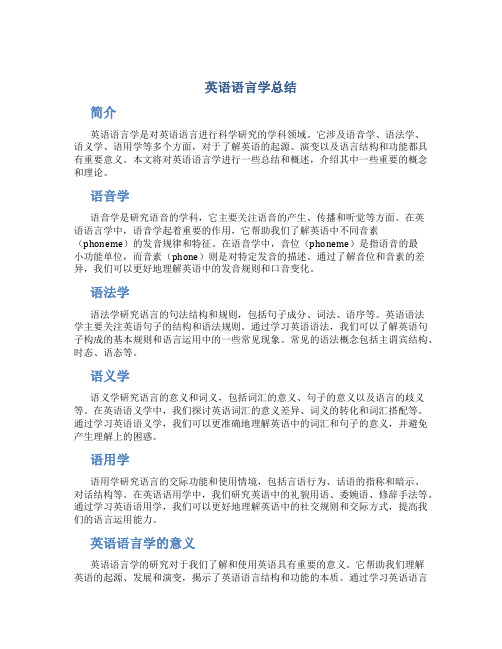
英语语言学总结简介英语语言学是对英语语言进行科学研究的学科领域。
它涉及语音学、语法学、语义学、语用学等多个方面,对于了解英语的起源、演变以及语言结构和功能都具有重要意义。
本文将对英语语言学进行一些总结和概述,介绍其中一些重要的概念和理论。
语音学语音学是研究语音的学科,它主要关注语音的产生、传播和听觉等方面。
在英语语言学中,语音学起着重要的作用,它帮助我们了解英语中不同音素(phoneme)的发音规律和特征。
在语音学中,音位(phoneme)是指语音的最小功能单位,而音素(phone)则是对特定发音的描述。
通过了解音位和音素的差异,我们可以更好地理解英语中的发音规则和口音变化。
语法学语法学研究语言的句法结构和规则,包括句子成分、词法、语序等。
英语语法学主要关注英语句子的结构和语法规则。
通过学习英语语法,我们可以了解英语句子构成的基本规则和语言运用中的一些常见现象。
常见的语法概念包括主谓宾结构、时态、语态等。
语义学语义学研究语言的意义和词义,包括词汇的意义、句子的意义以及语言的歧义等。
在英语语义学中,我们探讨英语词汇的意义差异、词义的转化和词汇搭配等。
通过学习英语语义学,我们可以更准确地理解英语中的词汇和句子的意义,并避免产生理解上的困惑。
语用学语用学研究语言的交际功能和使用情境,包括言语行为、话语的指称和暗示、对话结构等。
在英语语用学中,我们研究英语中的礼貌用语、委婉语、修辞手法等。
通过学习英语语用学,我们可以更好地理解英语中的社交规则和交际方式,提高我们的语言运用能力。
英语语言学的意义英语语言学的研究对于我们了解和使用英语具有重要的意义。
它帮助我们理解英语的起源、发展和演变,揭示了英语语言结构和功能的本质。
通过学习英语语言学,我们可以更好地掌握英语的发音、词汇、语法和语用等方面的知识,提高我们的英语语言能力。
此外,英语语言学还对翻译、教学、翻译和语言政策等领域有着重要的影响。
结论通过对英语语言学的总结,我们对英语语言的研究有了更深刻的认识。
TG——英语语言学理论
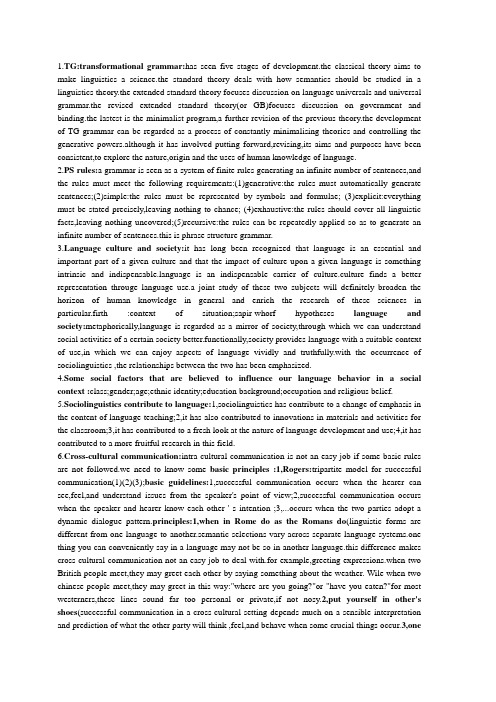
1.TG:transformational grammar:has seen five stages of development.the classical theory aims to make linguistics a science.the standard theory deals with how semantics should be studied in a linguistics theory.the extended standard theory focuses discussion on language universals and universal grammar.the revised extended standard theory(or GB)focuses discussion on government and binding.the lastest is the minimalist program,a further revision of the previous theory.the development of TG grammar can be regarded as a process of constantly minimalising theories and controlling the generative powers.although it has involved putting forward,revising,its aims and purposes have been consistent,to explore the nature,origin and the uses of human knowledge of language.2.PS rules:a grammar is seen as a system of finite rules generating an infinite number of sentences,and the rules must meet the following requirements:(1)generative:the rules must automatically generate sentences;(2)simple:the rules must be represented by symbols and formulae; (3)explicit:everything must be stated precisely,leaving nothing to chance; (4)exhaustive:the rules should cover all linguistic facts,leaving nothing uncovered;(5)recursive:the rules can be repeatedly applied so as to generate an infinite number of sentences.this is phrase structure grammar.nguage culture and society:it has long been recognized that language is an essential and important part of a given culture and that the impact of culture upon a given language is something intrinsic and nguage is an indispensable carrier of culture.culture finds a better representation througe language use.a joint study of these two subjects will definitely broaden the horizon of human knowledge in general and enrich the research of these sciences in particular.firth :context of situation;sapir-whorf hypotheses language and society:metaphorically,language is regarded as a mirror of society,through which we can understand social activities of a certain society better.functionally,society provides language with a suitable context of use,in which we can enjoy aspects of language vividly and truthfully.with the occurrence of sociolinguistics ,the relationships between the two has been emphasized.4.Some social factors that are believed to influence our language behavior in a social context :class;gender;age;ethnic identity;education background;occupation and religious belief.5.Sociolinguistics contribute to language:1,sociolinguistics has contribute to a change of emphasis in the content of language teaching;2,it has also contributed to innovations in materials and activities for the classroom;3,it has contributed to a fresh look at the nature of language development and use;4,it has contributed to a more fruitful research in this field.6.Cross-cultural communication:intra-cultural communication is not an easy job if some basic rules are not followed.we need to know some basic principles :1,Rogers:tripartite model for successful communication(1)(2)(3);basic guidelines:1,successful communication occurs when the hearer can see,feel,and understand issues from the speaker's point of view;2,successful communication occurs when the speaker and hearer know each other ' s intention ;3,...occurs when the two parties adopt a dynamic dialogue pattern.principles:1,when in Rome do as the Romans do(linguistic forms are different from one language to another.semantic selections vary across separate language systems.one thing you can conveniently say in a language may not be so in another language.this difference makes cross-cultural communication not an easy job to deal with.for example,greeting expressions.when two British people meet,they may greet each other by saying something about the weather. Wile when two chinese people meet,they may greet in this way:"where are you going?"or "have you eaten?"for most westerners,these lines sound far too personal or private,if not nosy.2,put yourself in other's shoes(successful communication in a cross-cultural setting depends much on a sensible interpretation and prediction of what the other party will think ,feel,and behave when some crucial things occur.3,oneculture's meat is another culture's poison(proverbs epitomize the essence of culture and the value system of society. A cross-linguistic survey of proverbial expressions will capture another point of interest:how do people from different cultures look at their relationships with animals? A ready example is found in English"love me ,love my dog". An equivalent in chinese will be "love me ,love my bird".these two proverbs reveal different attitudes English and Chinese speakers cherish toward these pets. This disparity ,if not cautioned,will invite unpleasantness in society. An expression is likely to take on different social significance,goos or bad,friendly or hostile,depending on a very important sociolinguistic rule of communication:who speaks what,to whom,when,where,and for what purpose(fishman).similarly, correct interpretation and smooth communication rely on a group of relevant factors.the implication the speaker wants to convey is one,the social relationships between interlocuters become another and a specific setting where communication takes place constituents a third.if these pre-conditional requirements are not met,it will produce compliant,unpleasantness and misunderstanding in a new cultural context.7.What are the three important points of the Prague School?First, it was stressed that the synchronic study of language is fully justified as it can draw on complete and controllable material for investigation but no rigid theoretical barrier is erected to separate diachronic study. Second, there was an emphasis on the systemic character of language. No element of any language can be satisfactorily analyzed or evaluated if viewed in isolation. Third, language was looked on as functional in another sense, that is, as a tool performing a number of essential functions or tasks for the community using it.8.How do you understand Chomsky’s L anguage Acquisition device:Chomsky believes that language is somewhat innate, and that children are born with a Language Acquisition Device, which is a unique kind of knowledge that fits them for language learning. He argues the child comes into the world with specific innate endowment, not only with general tendencies or potentialities, but also with knowledge of the nature of the world, and specifically with the knowledge of the nature of language. According to this view, children are born with knowledge of the basic grammatical relations and categories, and this knowledge is universal. The categories and relations exist in all human languages and all human infants are born with knowledge of them. According to him, the study of language, or the structure of language, can throw some light on the nature of the human mind. This approach to language is a reaction against behaviourism in psychology and empiricism in philosophy, making linguistics a branch of psychology.9.Three objectives to teach culture in our language class:1,to get the students familiar with cultural differences;2,to help the students transcend their own culture and see things as the members of the target culture will;3,to emphasize the inseparability of understanding language and understanding culture through various classroom practices.1.Philosophers use connotation to mean the properties of the entity a word denotes.2.In the middle of 1960s, William Labov, a famous sociolinguist, conducted a rather meticulous survey at several departments in the City of New York.to examine the relationship between the speakers’ social stat us and their phonological variations.3.Applied linguistics serves as a mediating area which interprets the results of linguistic theories and makes them user-friendly to the language teacher and learner.4.Modern linguistics began from the Swiss linguist Ferdinand de Saussure who is often described as “father of modern linguistics”.5.The Prague School is best known and remembered for its contribution to phonology and the distinction between phonetics and phonology.Saussure......structuralism Roman Jacobson.......distinctive features P.Grice.......Theory of conversational implicature; cooperative principle John Lanoshaw Austin.....speech act theory Chomsky.....TG,LAD(language acquisition device)G.Leech......7 types of meaning in<senmantics> Radford.....MOP Hjemslev......Paradigmatic relations Katz and Fodor.......an integrated theory(compositionality) Firth........theory of context of situation;prosodic or analysis phonology M.A.K Halliday.........SF(systemic-functional grammar) Lakoff.........You are what you say Rogers........tripartite model municative dynamisn Franz Boas.......American structuralism。
英语教育中的语言学理论
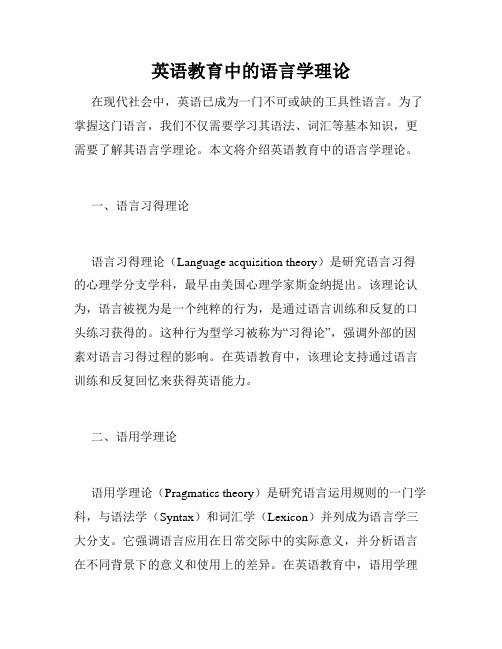
英语教育中的语言学理论在现代社会中,英语已成为一门不可或缺的工具性语言。
为了掌握这门语言,我们不仅需要学习其语法、词汇等基本知识,更需要了解其语言学理论。
本文将介绍英语教育中的语言学理论。
一、语言习得理论语言习得理论(Language acquisition theory)是研究语言习得的心理学分支学科,最早由美国心理学家斯金纳提出。
该理论认为,语言被视为是一个纯粹的行为,是通过语言训练和反复的口头练习获得的。
这种行为型学习被称为“习得论”,强调外部的因素对语言习得过程的影响。
在英语教育中,该理论支持通过语言训练和反复回忆来获得英语能力。
二、语用学理论语用学理论(Pragmatics theory)是研究语言运用规则的一门学科,与语法学(Syntax)和词汇学(Lexicon)并列成为语言学三大分支。
它强调语言应用在日常交际中的实际意义,并分析语言在不同背景下的意义和使用上的差异。
在英语教育中,语用学理论为学生了解英语在不同场合下的使用和语气、联想等方面提供了重要的指导。
三、认知语言学理论认知语言学理论(Cognitive Linguistics)是一种新兴的语言学派别,它探讨语言与思维之间的关系,研究语言知识的认知和构建方式。
该理论认为,语言的意义是由认知语言处理机制产生的,语言的规律来自于认知建构活动。
在英语教育中,认知语言学理论强调学习者将语言的概念与自己的认知结构进行联系,从而更好地理解和掌握语言。
四、社会语言学理论社会语言学理论(Sociolinguistics)分析语言在社会上的使用和使用者的社会环境的影响。
社会语言学理论强调文化和社会因素对语言使用的影响,并研究它们如何影响书面和口头语言的发展。
在英语教育中,社会语言学理论可以帮助学生了解不同文化背景和社会环境对语言的影响,更加深入地了解和运用语言。
总之,语言学理论可以为我们更好地理解和掌握英语提供帮助。
作为英语学习者,我们应该不断更新自己对语言学理论的知识,并将其运用到实际学习当中。
英语语言学理论与应用研究

英语语言学理论与应用研究英语语言学是研究英语语言的结构、功能和历史演变的学科。
它旨在探究英语语言的规则和运用,并将其应用于教学、翻译、语言规划等实际领域。
英语语言学的理论与应用研究的重要性在于帮助我们更好地理解和运用英语,提高英语教学与翻译的质量。
英语语言学理论主要包括语音学、语法学、词汇学、语用学和语篇分析等方面。
语音学研究语音单位的构成和组织规律,通过音素、音节等单位来描述和分析发音。
语法学研究语言单位的组织形式和句子的结构规则,包括词类、句型和语序等。
词汇学研究词汇的构成和语义特征,了解词汇的意义、拼写和用法。
语用学研究语言使用的背景、目的和意图,探讨语言在交际中的功能和效果。
语篇分析研究语言在语篇中的运用,分析语句之间的关系和上下文的作用。
在英语语言学的应用研究中,教学是其中的重要领域之一。
英语教学应用研究借鉴英语语言学的理论,将其运用于实际教学中,提高教学效果。
比如,通过语音学的研究,我们可以帮助学生正确发音,纠正口音。
通过语法学的研究,我们可以帮助学生理解句子的结构,运用正确的语法规则。
通过词汇学的研究,我们可以帮助学生扩大词汇量,提高词汇运用能力。
通过语用学的研究,我们可以培养学生的交际能力,使他们能够在实际交流中更好地运用英语。
通过语篇分析的研究,我们可以帮助学生理解上下文,掌握文章的主旨和总体逻辑。
另外,英语语言学的应用研究还涉及到翻译和语言规划等领域。
翻译是将一种语言的表达方式转换成另一种语言的过程,而英语语言学的应用研究可以帮助翻译人员理解源语言和目标语言的差异,选择合适的表达方式。
语言规划是指对一种语言的使用和发展进行系统规范和管理,英语语言学的应用研究可以为语言规划提供理论支持和实际指导,促进英语的规范化和标准化。
总之,英语语言学的理论与应用研究对于我们理解和运用英语都具有重要意义。
通过研究语音学、语法学、词汇学、语用学和语篇分析等方面的理论,我们可以更好地理解英语语言的构成和运用规则。
英语语言学

英语语言学语言学普遍被定义为对语言进行科学研究,他试图回答如下基本问题:什么是语言,语言是如何运作的。
主要包括了普通语言学,语音学,音位学,形态学,句法学,语义学,语用学等部分。
本文重点介绍了语音学,音位学和形态学,并提出了学习中一些自己的想法。
一语音学口语交际的媒介是语音(speech sounds),也就是说人们通过声道(vocal track)发出的音来表达意义。
这种对语音的研究被叫做语音学(phonetics)。
语音学主要包括了如下内容。
发音器官语音是由各种发音器官(speech organ)而产生的。
因此,正确理解语音需要掌握相关的发音系统知识。
人的发音器官包含在咽腔,口腔,鼻腔三个区域中。
英语语音的表征方法通常我们使用国际音标来代表语音,也就是我们常说的宽式音标。
在描写语音时,为了体现语音的细微差异,语言学使用更为详细的标音方法,有时被称为严式记音(narrow transcription)。
在窄式记音中,一些较小符号经常被附加在音标上,如鼻化符[ ˘ ]、重音符[ˊ]等。
这些改变音值的较小记号叫做变音符(diacritic)。
英语语音的分类英语语音主要分为元音(vowels)和辅音(consonants) 两类。
他们的主要区别是:发元音时,发音器官不形成阻碍,气流可以畅通无阻地经口腔或鼻腔流出;发辅音时,发音器官某一部位形成阻碍,气流必须克服阻碍才能通过。
辅音可以根据发音部位(places of articulation)、发音方式(manners of articulation)进行分类和描写。
在发元音时,没有类似发辅音时产生的气流受阻的现象,因此,描写元音不能沿用描写辅音的方法。
语言学家通常依据以下三个原则对元音进行描写:(1)嘴的张合度; (2)舌头抬升的部位---- 前、中、后;(3)唇的开合度——唇的圆或展的不同程度;二音位学音位学(phonology)和语音学一样都是对语音的研究,但两者研究的视角却不同。
现代英语语言学理论 CHAPTER 8

Pragmatics may be defined as the study of meaning. The word meaning may have many different meanings. In semantics, meaning depends more on who the speaker of the sentence is, who the hearer is, when and where it is used. Meaning depends more on the context.
8.2 Speech Act Theory
This theory originated with the Oxford philosopher John Langshaw Austin. In 1955, when he went to America to deliver the William James lectures, he revised the notes and changed the title from Words and Deeds to How to Do Things with Words, which was published posthumously in 1962.
8.1 Pragmatics
Or rather, you do know the speaker’s intention, but you want to use “What do you mean?” as a denial of what he has asserted. This kind of meaning is sometimes referred to as SPEAKER’S MEANING, UTTERANCE MEANING, or CONTEXTUAL MEANING. The discipline, which concentrates on this kind of meaning, is called PRAGMATICS.
- 1、下载文档前请自行甄别文档内容的完整性,平台不提供额外的编辑、内容补充、找答案等附加服务。
- 2、"仅部分预览"的文档,不可在线预览部分如存在完整性等问题,可反馈申请退款(可完整预览的文档不适用该条件!)。
- 3、如文档侵犯您的权益,请联系客服反馈,我们会尽快为您处理(人工客服工作时间:9:00-18:30)。
Lecture 2
2.2. Language teaching research
2.2.1 The Characteristic features of langauge teaching research
1) Language teaching research is an independent discipline.
2) Language teaching research is an interdisciplihary science.
3) Language teaching research is an applied science.
4) Language teaching research is an empirical science.
2.2.2 The Issues of language teaching research
a. Comparative study: of native speakers and non-native speakers, of target language and native language, of L2 learning of children and adults.
b. learning and teaching study: learning & acquisition, L2 teaching,
c. Learner study: attitudes & motivation, learning strategies & style,
d. Language study: communicative aspects, structure of convensation, code-switching, linguistic aspects of computer-assisted learning
2.2.3 possible fields of language teaching research
1)The models of linguistic theory and linguistic description
2)The models of language learning
3)The application of the theoretical models
The four areas of LT
--syllabus design, compilation of teaching material, classroom
teaching, testing/evaluation
4)Classroom teaching practice
2.2.4 Some essential factors affecting L2 learning
3. Language
3.1 Definition of language
It is really just as difficult to define language as it is to define man.
人:是一切社会关系的总和;
是唯一能把动物养成宠物和煮成食物的动物;
是一种会笑的动物;
"Language is a system of arbitrary vocal symbols used for human communication" Wardhaugh in his "Introduction to Linguistics" (1972).语言是用于人类交际的、任意的、有声的符号系统
3.2 Design Features of Language
1) Arbitrariness---There is no logical (intrinsic or direct) connection between the sound/sign and meaning, between the word and its object, between the grammar and the meaning it carries;
or the forms of linguistic signs bear no natural relationship to their meaning.
A building we live in with our family
--house in English, maison in French, dom in Russion, casa in Spanish, fangzi in Chinese
However, language is not entirely arbitrary; there are cases where there seems to be some association between sounds and meaning, e.g.
Onomatopoetic words: bang,
Some compound words: tractor driver shoe-maker
The other side of the coin of arbitrariness is conventionality. The link between linguistic sign and its meaning is a matter of convention.
A pair of trousers---- A pair of shirts
Go shopping *go buying go hunting
冬瓜(white gourd) (夏天吃的)
北戴河is not a river 中南海is not a sea.
食堂餐厅 *餐堂 *食厅
外公—外婆*外母老公—老婆*老母
英国的语言---- 英文英语
中国的语言----中文(*中语)汉语
昨天昨晚 *昨早 *昨月 *昨年
去年 *去天 *去晚 *去月
明天明年 *明月 *明周
今天今年 *今月
二百五----傻里傻气的人
生前好友已婚夫妇未婚妻
七嘴八舌----七张嘴里如果长出把条舌头,其中必有一人为“怪胎”
四季如春----夏春秋三季温暖如春,为比喻。
“春季如春”则文理不通。
三长两短、七上八下三下五除二
2) Duality
Two levels:
Lower level---- a limit set of sounds, meaningless
Higher level----units of meaning coming from the combination of the units of lower level
Phoneme—morpheme—words—phrase—clause—sentence
3) Productivity--The users of a language can utilize a limited linguistic
rules to produce or understand infinite meaningful linguistic forms, including those they have never heard before.
The man that the girl that my wife taught married published many poems. (和我妻子教的那个女孩结婚的那个男人发表了许多诗)
他一边脱衣服,一边穿裤子。
(小学生的造句练习)
4) Displacement---Language can be used to tallk about what happened in the past, what is happening at present, or what will happen in the future. Also we can use language to refer to things no matter how far away they are or whether they are real or imagined.
5) Cultural Transmission----A language system is not genetically transmitted, but culturally transmitted. That is, a language system is passed on from
one generation to another by teaching and learning rather than by instict.
衣服搭配,时尚女装搭配,女装9元包邮
EkO07w03u85r。
